engine Citroen C1 RHD 2016 1.G Service Manual
[x] Cancel search | Manufacturer: CITROEN, Model Year: 2016, Model line: C1 RHD, Model: Citroen C1 RHD 2016 1.GPages: 268, PDF Size: 7.09 MB
Page 112 of 268
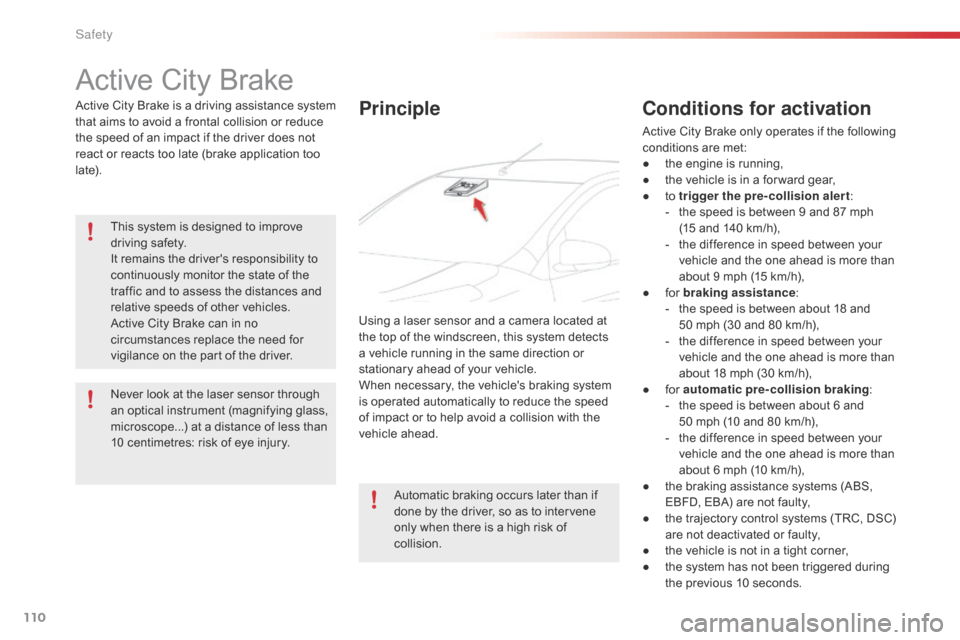
110
Active City Brake
Active City B rake i s a d riving a ssistance s ystem t
hat aims to avoid a frontal collision or reduce
t
he speed of an impact if the driver does not
r
eact or reacts too late (brake application too
l
ate). This
system is designed to improve
d
riving safety.
It
remains the driver's responsibility to
c
ontinuously monitor the state of the
t
raffic and to assess the distances and
r
elative speeds of other vehicles.
Active
City Brake can in no
c
ircumstances replace the need for
v
igilance on the part of the driver.
Never
look at the laser sensor through
a
n optical instrument (magnifying glass,
m
icroscope...) at a distance of less than
1
0 centimetres: risk of eye injury.Automatic
braking occurs later than if
d
one by the driver, so as to intervene
o
nly when there is a high risk of
c
ollision.Principle
Using a laser sensor and a camera located at the top of the windscreen, this system detects
a
vehicle running in the same direction or
s
tationary ahead of your vehicle.
When
necessary, the vehicle's braking system
i
s operated automatically to reduce the speed
o
f impact or to help avoid a collision with the
v
ehicle
a
head.
Conditions for activation
Active City Brake only operates if the following
c onditions are met:
●
t
he engine is running,
●
t
he vehicle is in a for ward gear,
●
t
o trigger the pre-collision alert :
-
t
he speed is between 9 and 87 mph
(
15 and 140 km/h),
-
t
he difference in speed between your
v
ehicle and the one ahead is more than
a
bout 9 mph (15 km/h),
●
f
or braking assistance :
-
t
he speed is between about 18 and
5
0 mph (30 and 80 km/h),
-
t
he difference in speed between your
v
ehicle and the one ahead is more than
a
bout 18 mph (30 km/h),
●
f
or automatic pre-collision braking:
-
t
he speed is between about 6 and
5
0 mph (10 and 80 km/h),
-
t
he difference in speed between your
v
ehicle and the one ahead is more than
a
bout 6 mph (10 km/h),
●
t
he braking assistance systems (ABS,
E
BFD, EBA) are not faulty,
●
t
he trajectory control systems (TRC, DSC)
a
re not deactivated or faulty,
●
t
he vehicle is not in a tight corner,
●
t
he system has not been triggered during
t
he previous 10 seconds.
Safety
Page 113 of 268

111
Operation
Three levels of operation are possible:
● P re-collision alert :
if a risk of collision w
ith a vehicle is detected, a warning lamp
c
omes on in the instrument panel together
w
ith an audible signal to encourage the
d
river to make an avoiding manoeuvre. The
t
hresholds for triggering the alert can be set.
●
Br
aking assistance :
increases the
b
raking started by the driver, only if a risk
o
f collision is detected.
●
A
utomatic pre-collision braking:
when
y
our vehicle is too close to or closing
t
oo quickly on the vehicle ahead of you,
t
he system automatically operates the
b
rakes to reduce the speed of impact. A
c
ollision can be avoided automatically if the
d
ifference in speed between your vehicle
a
nd
t
he
o
ne
a
head
i
s
n
ot
m
ore
t
han
1
8
m
ph
(
30 km/h).You
are then alerted by the display of
t
his warning lamp, accompanied by
a
n audible signal. The
automatic braking may bring the vehicle to a
complete stop if the situation requires it.
The
brake lamps on your vehicle come on to
w
arn other road users. The
triggering of the system may cause
t
he engine to stall, unless the driver
d
epresses the clutch pedal quickly
e
nough during automatic braking.
6
Safety
Page 114 of 268
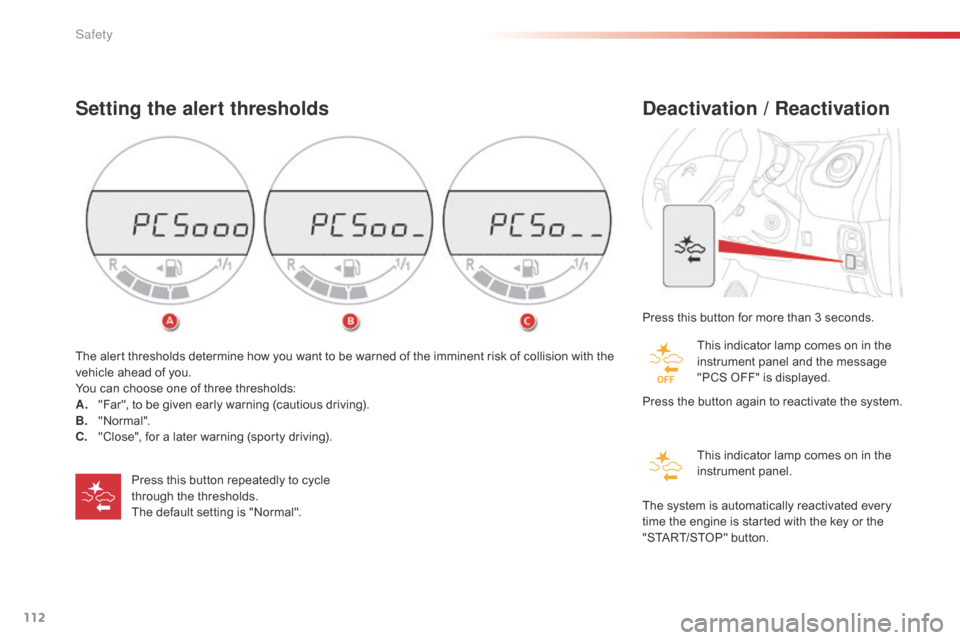
112
Setting the alert thresholds
Press this button repeatedly to cycle through the thresholds.
The
default setting is "Normal".
The
alert
thresholds determine how you want to be warned of the imminent risk of collision with the
v
ehicle
ahead of you.
You
can
choose one of three thresholds:
A.
"
Far",
to be given early warning (cautious driving).
B.
"
Normal".
C.
"
Close", for a later warning (sporty driving).
Deactivation / Reactivation
Press this button for more than 3 seconds.
P ress the button again to reactivate the system.
The
system is automatically reactivated every
t
ime the engine is started with the key or the
"
START/STOP" button.
This
indicator lamp comes on in the
in
strument
pan
el.
This
indicator lamp comes on in the
i
nstrument panel and the message
"
PCS OFF" is displayed.
Safety
Page 140 of 268

138
Fuel tank
Low fuel levelRefuelling
When the low fuel level is reached, t
his warning lamp comes on,
a
ccompanied by an audible signal.
The
message "LO FUEL" is displayed in place
o
f
the
range.
You have approximately 5 litres remaining.
In
certain
driving conditions and depending on
t
he
engine, the distance which can be travelled
w
ith
the
fuel remaining may be less than
3
0 miles
(50 km). To
refuel in complete safety:
F
Y
ou must stop the engine and switch off
the ignition (ignition in "LOCK" position
or "OFF" mode) .
F
P
ull the control on the lower dashboard,
d
river's side, to release the filler flap.
F
O
pen the fuel filler flap.
If
you run out of fuel, the emission
c
ontrol system warning lamp may come
o
n
in the instrument panel. It will go off
a
utomatically after the engine has been
s
tarted a few times. Refuelling
must only be done with the engine
stopped and the ignition switched off ( ignition s
witch in the "LOCK" position or " OFF"
mode).
The capacity of the fuel tank is approximately 35 litres.
Additions of fuel must be of at least 5 litres to
b
e registered by the fuel gauge.
A
label on the inside of the flap reminds you
w
hich type of fuel to use.
There
may be an inrush of air when removing
t
he filler cap. This vacuum is per fectly normal
a
nd results from the sealing of the fuel system.
Practical information
Page 141 of 268

139
F Unscrew the filler cap and place it on its c
arrier (on the filler flap).
F
I
nsert the filler nozzle as far as it will go,
b
efore starting delivery of fuel (risk of blow-
back).
F
K
eep the nozzle in this position while
refuelling.
Quality of the fuel used for
petrol engines
The petrol engines are compatible with
E 10 type petrol biofuels (containing
10
% ethanol), conforming to European
s
tandards EN 228 and EN 15376.
E85
type fuels (containing up to 85 % ethanol)
a
re reserved exclusively for vehicles marketed
f
or the use of this type of fuel (BioFlex
v
ehicles). The quality of the ethanol must
c
omply with European standard EN 15293.
Once
refuelling
is
complete:
F
F
it
and
tighten
the
filler
cap
until
you
hear
a
c
lick.
W
hen you release the filler cap, it turns
slightly
in
the
opposite
direction.
F
P
ush
the
filler
flap
to
close
it.
When you fill the fuel tank, do not continue
after the 3rd cut- off of the pump; this could
cause malfunctions.
Your
vehicle
is
fitted
with
a
catalytic
converter
t
hat
reduces
harmful
exhaust
emissions.
The
filler
neck
has
a
narrower
aperture
that
o
nly
admits
nozzles
on
pumps
delivering
unl
eaded petrol .
7
Practical information
Page 143 of 268
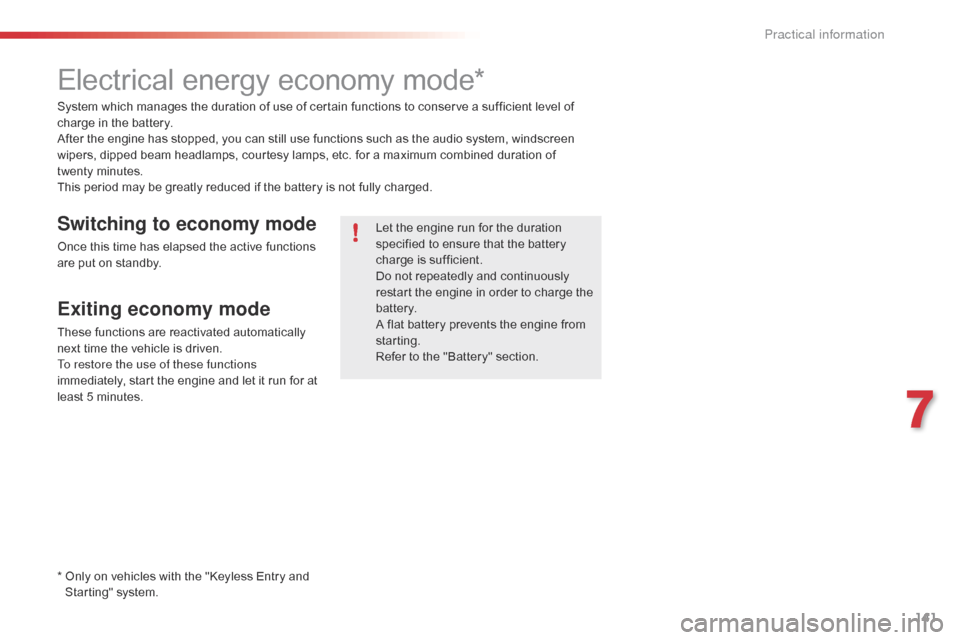
141
Electrical energy economy mode*
System which manages the duration of use of certain functions to conserve a sufficient level of charge in the battery.
After
the engine has stopped, you can still use functions such as the audio system, windscreen
w
ipers, dipped beam headlamps, courtesy lamps, etc. for a maximum combined duration of
t
wenty minutes.
This
period may be greatly reduced if the battery is not fully charged.
Let
the engine run for the duration
s
pecified to ensure that the battery
c
harge is sufficient.
Do
not repeatedly and continuously
r
estart the engine in order to charge the
b
attery.
A
flat battery prevents the engine from
s
tarting.
Refer
to the "Battery" section.
Switching to economy mode
Once this time has elapsed the active functions are put on standby.
Exiting economy mode
These functions are reactivated automatically next time the vehicle is driven.
To restore the use of these functions
immediately,
start the engine and let it run for at
l
east 5 minutes.
*
O
nly on vehicles with the "Keyless Entry and
S
tarting" system.
7
Practical information
Page 147 of 268
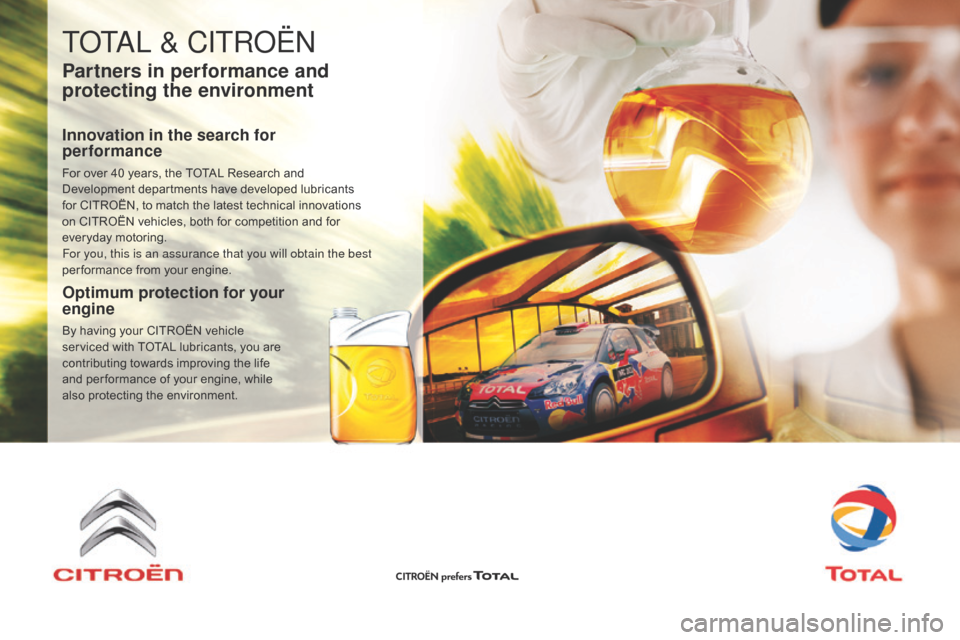
TOTAL & CITROËN
Partners in performance and
protecting the environment
Innovation in the search for
performance
For over 40 years, the TOTAL Research and Development departments have developed lubricants
f
or CITROËN, to match the latest technical innovations
o
n CITROËN vehicles, both for competition and for
e
veryday motoring.
For you, this is an assurance that you will obtain the best
per formance
from your engine.
Optimum protection for your
engine
By having your CITROËN vehicle serviced with TOTAL lubricants, you are
c
ontributing towards improving the life
a
nd per formance of your engine, while
a
lso protecting the environment.
Page 148 of 268
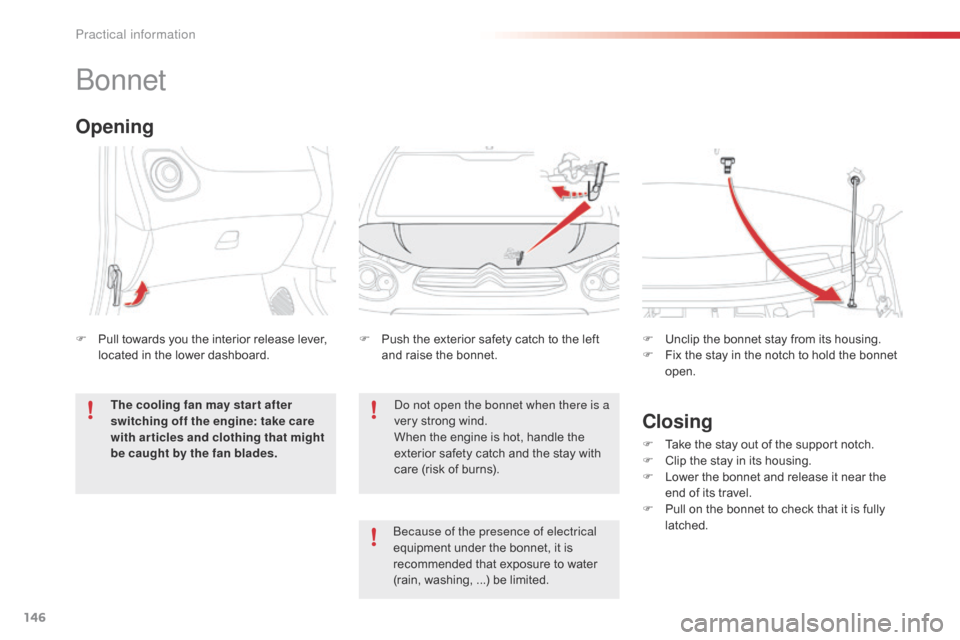
146
Bonnet
Do not open the bonnet when there is a
very strong wind.
When
the engine is hot, handle the
e
xterior safety catch and the stay with
c
are (risk of burns).
F
P
ush the exterior safety catch to the left
a
nd raise the bonnet.
F
U
nclip the bonnet stay from its housing.
F
F
ix the stay in the notch to hold the bonnet
ope
n.
Opening
F Pull
towards you the interior release lever, l
ocated in the lower dashboard.
The cooling fan may star t after
switching off the engine: take care
with articles and clothing that might
be caught by the fan blades.
Closing
F Take the stay out of the support notch.
F C lip the stay in its housing.
F
L
ower the bonnet and release it near the
e
nd of its travel.
F
P
ull on the bonnet to check that it is fully
l
atched.
Because of the presence of electrical
equipment
under
the
bonnet,
it
is
r
ecommended
that
exposure
to
water
(
rain,
washing,
...)
be
limited.
Practical information
Page 149 of 268
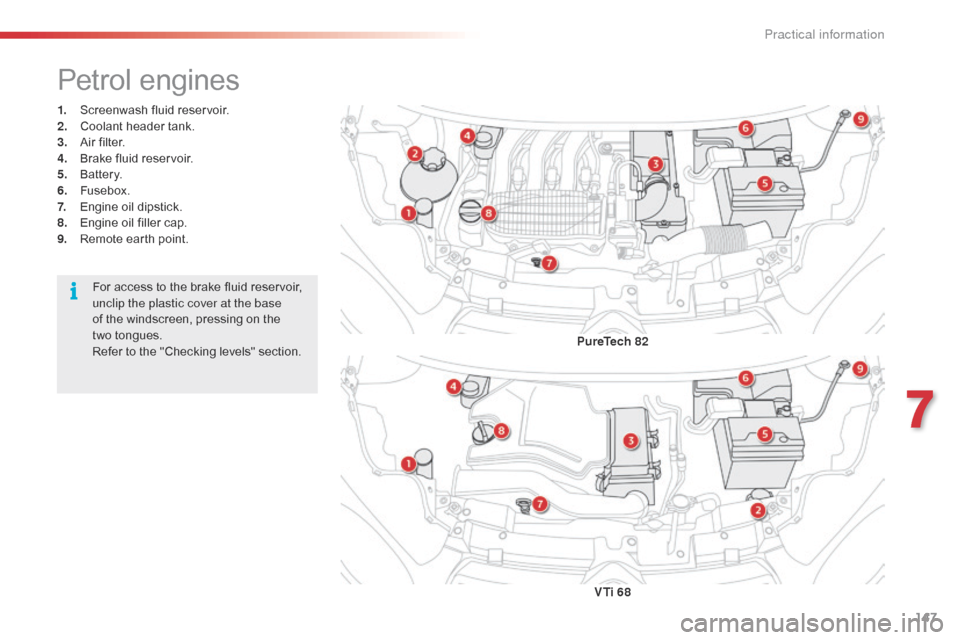
147
1. Screenwash fluid reservoir.
2. C oolant header tank.
3.
A
ir filter.
4.
B
rake fluid reservoir.
5.
B
attery.
6.
F
usebox.
7.
E
ngine oil dipstick.
8.
E
ngine oil filler cap.
9.
R
emote earth point.
Petrol engines
PureTech 82
VTi 68
For
access
to
the
brake
fluid
reservoir,
u
nclip the plastic cover at the base
of
the
windscreen,
pressing
on
the
t
wo tongues.
Refer
to
the
"Checking
levels"
section.
7
Practical information
Page 150 of 268
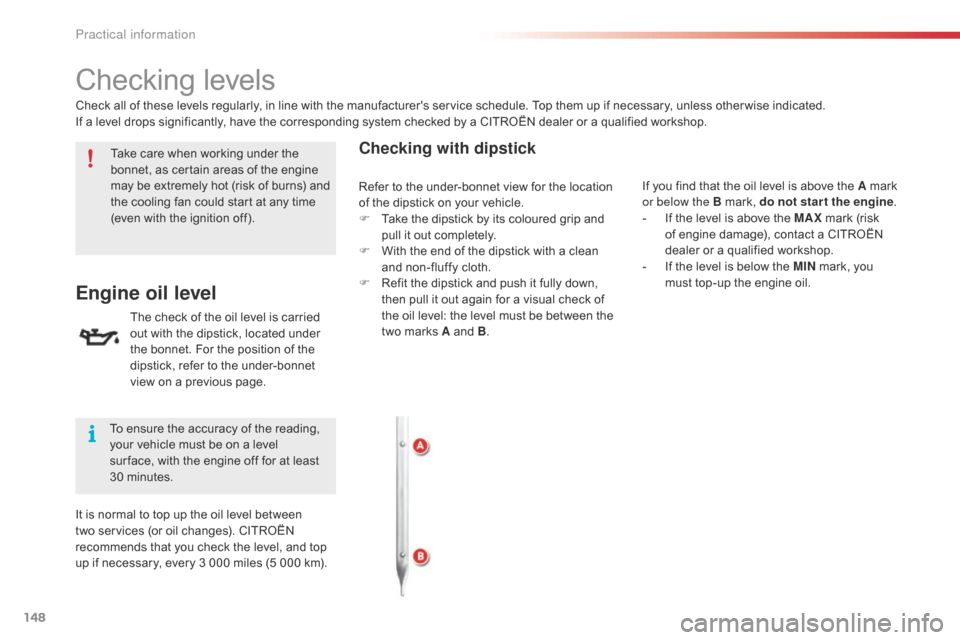
148
Checking levels
Take care when working under the bonnet, as certain areas of the engine
m
ay be extremely hot (risk of burns) and
t
he cooling fan could start at any time
(
even with the ignition off).
Engine oil level
The check of the oil level is carried out with the dipstick, located under
t
he bonnet. For the position of the
d
ipstick, refer to the under-bonnet
v
iew on a previous page.
Checking with dipstick
Check all of these levels regularly, in line with the manufacturer's service schedule. Top them up if necessary, unless other wise indicated.
I f a level drops significantly, have the corresponding system checked by a CITROËN dealer or a qualified workshop.
To
ensure the accuracy of the reading,
y
our vehicle must be on a level
s
ur face, with the engine off for at least
3
0 minutes.
It
is normal to top up the oil level between
t
wo services (or oil changes). CITROËN
r
ecommends that you check the level, and top
u
p if necessary, every 3 000 miles (5 000 km). If
you find that the oil level is above the A mark
o
r below the B mark, do not star t the engine.
-
I
f the level is above the MAX
mark (risk
o
f engine damage), contact a CITROËN
d
ealer or a qualified workshop.
-
I
f the level is below the MIN
mark, you
m
ust top-up the engine oil.
Refer
to the under-bonnet view for the location
o
f the dipstick on your vehicle.
F
T
ake the dipstick by its coloured grip and
p
ull it out completely.
F
W
ith the end of the dipstick with a clean
a
nd non-fluffy cloth.
F
R
efit the dipstick and push it fully down,
t
hen pull it out again for a visual check of
t
he oil level: the level must be between the
t
wo marks A and B.
Practical information